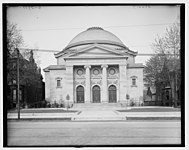Bonstelle Theatre
Temple Beth-El | |
U.S. National Register of Historic Places | |
U.S. Historic district Contributing property | |
 | |
| Location | 3424 Woodward Avenue Detroit, Michigan |
|---|---|
| Coordinates | 42°20′45.92″N 83°3′24.86″W / 42.3460889°N 83.0569056°WCoordinates: 42°20′45.92″N 83°3′24.86″W / 42.3460889°N 83.0569056°W |
| Built | 1902 |
| Architect | Albert Kahn; C. Howard Crane |
| Architectural style | Beaux-Arts |
| Part of | Midtown Woodward Historic District (ID08001106) |
| MPS | Religious Structures of Woodward Ave. TR |
| NRHP reference No. | 82002911[1] |
| Significant dates | |
| Added to NRHP | August 3, 1982 |
| Designated CP | November 26, 2008 |
The Bonstelle Theatre is a theater operated by Wayne State University, and located at 3424 Woodward Avenue (the southeast corner of Woodward and Eliot) in the Midtown Woodward Historic District of Detroit, Michigan.[2] It was built in 1902 as the Temple Beth-El, and was listed on the National Register of Historic Places in 1982.[1] As of 2019, the University plans to decommission the theatre and lease it to a private developer for inclusion in a boutique hotel.[3][4]
Construction[]
When Rabbi Leo M. Franklin first began leading services at Detroit's Temple Beth El in 1899, he felt that the construction of a new temple building on Detroit's "Piety Row" stretch of Woodward would increase the visibility and prestige of Detroit's Jewish community.[2] Accordingly, in October 1900, the congregation held a special meeting at which it was decided to build a new temple. The congregation purchased a site for the new temple in April of the next year and engaged member Albert Kahn to design the structure. Groundbreaking took place on November 25, 1901, with the ceremonial cornerstone laid on April 23, 1902. The first services were held in the chapel on January 24, 1903, and the formal dedication was held on September 18–19 of the same year.[5]
Building[]
The temple is a Beaux-Arts structure influenced primarily by Roman and Greek temples. Sobocinski cites the Pantheon in Rome for comparison. There is a prominent dome over the main area of the temple, with gabled wings on the north and south. A pedimented extension on the front once extended into a porch; the front section of the building was lost when the city widened Woodward Avenue in 1936.[2]
Later use[]
When the Temple Beth El congregation constructed a new building farther north along Woodward in 1922, they sold the building at Woodward and Eliot to Jessie Bonstelle for $500,000.[6] Bonstelle hired architect C. Howard Crane to convert the building into a theater, and named the resulting building the Bonstelle Playhouse.[6] In 1928, the Bonstelle Playhouse became the Detroit Civic Theatre, and in the 1930s, the Mayfair Motion Picture Theater. In 1951, Wayne State University rented the facility as a performance space for its theater company, and purchased it outright in 1956, renaming it the Bonstelle Theatre in honor of Jessie Bonstelle.
The University continues to use the theatre through Spring 2020 after which it will lease the facility to The Roxbury Group for renovation and redevelopment. The University will continue to produce in the Hilberry Theatre and until the completion of the Gateway Performing Arts Center which is scheduled to open in Fall of 2021.[7]
Gallery[]

Temple Beth El, c. 1905

Jessie Bonstelle in 1908

View of the theater from the south, with the name visible near the roof of the stagehouse
See also[]
- History of the Jews in Metro Detroit
References[]
- ^ a b "National Register Information System". National Register of Historic Places. National Park Service. January 23, 2007.
- ^ a b c Temple Beth-El Archived 2013-10-02 at the Wayback Machine from Detroit 1701.org.
- ^ Pinho, Kirk (March 20, 2019). "Roxbury's Bonstelle Theatre lease OK'd as part of 12-story West Elm boutique hotel project". Crain's Detroit Business.
- ^ Hernandez, Susana (July 9, 2018). "WSU to decommission historical Bonstelle Theatre". The South End.
- ^ Katz, Irving I.; Jacob Rader Marcus (1955). The Beth El Story: With a History of Jews in Michigan Before 1850. Detroit: Wayne State University Press. pp. 96–101.
- ^ a b "Bonstelle: Celebrating 100 Years of History" (Press release). Wayne State University. October 23, 2003. Archived from the original on September 1, 2006.
- ^ "Theatre and Dance at Wayne Announces the Last Full Season in the Hilberry Theatre Before Moving to Gateway Performing Arts Center" (Press release). Wayne State University. December 13, 2019. Retrieved May 31, 2020.
Further reading[]
- Hill, Eric J. and John Gallagher (2002). AIA Detroit: The American Institute of Architects Guide to Detroit Architecture. Wayne State University Press. ISBN 0-8143-3120-3.
- Sobocinski, Melanie Grunow (2005). Detroit and Rome: building on the past. Regents of the University of Michigan. ISBN 0933691092.
External links[]
| Wikimedia Commons has media related to Bonstelle Theatre. |
- Bonstelle Theatre - Wayne State University
- Photographs from the Rabbi Leo M. Franklin archives: these include photographs c. 1903 - 1922 of both the interior and exterior of the structure.
- Wayne State University
- Theatres in Detroit
- Midtown Detroit
- Woodward Avenue
- Former synagogues in the United States
- Jews and Judaism in Detroit
- Synagogues completed in 1902
- Historic district contributing properties in Michigan
- National Register of Historic Places in Detroit
- Properties of religious function on the National Register of Historic Places in Michigan
- Event venues established in 1922
- 1922 establishments in Michigan
- Albert Kahn (architect) buildings
- Beaux-Arts architecture in Michigan
- Former religious buildings and structures in Michigan
- Synagogue buildings with domes






